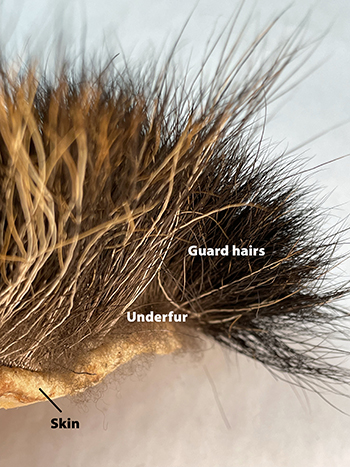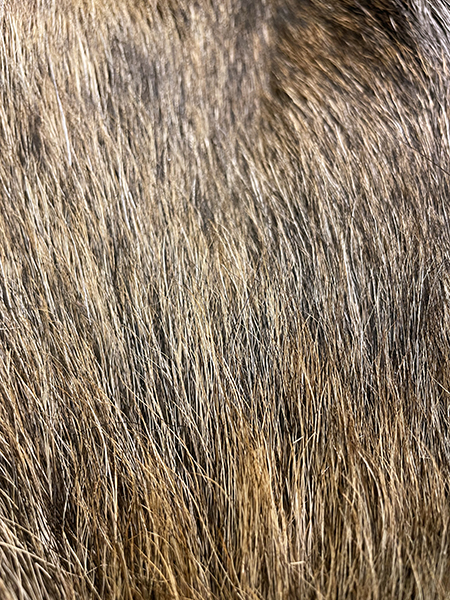Alaska Fish & Wildlife News
December 2024
Ask a Biologist
The Air in Moose Hair

Question from 8th grade student at Birchtree Charter School - Matanuska-Susitna Borough School District
Q) Why is moose hair so brittle?
Moose are found throughout most of Alaska, and as residents, survive extreme winter conditions every year. Late fall, as the days get shorter and temperatures drop, is the perfect time to think about how fur helps moose stay warm through the darkest, coldest months of the year.
First, some basics about mammal fur. Most mammals have slender, thread-like hair made of proteins covering most of their body. When hair covers the entire body, it is called fur, and another word for the full fur coat of a mammal is pelage. The hairs that make up fur are made primarily of a protein called keratin, which also is a key protein in human hair and nails. Bird feathers, animal claws, and reptile scales are also made of keratin.
Moose, like most mammals, have two layers of fur: guard hairs and underfur. Guard hairs help protect the shorter, softer underfur, and often give the pelage of the animal its color. Underfur is finer and denser than guard hair, and responsible for most of the insulation and warmth that animals get from their fur.
Mammals have a few other kinds of hair or specialized versions of hair. Porcupine quills are specialized guard hairs that help protect them from predators. Whiskers are tactile hairs - modified hairs that act as sensors. Seals rely on their whiskers to help them sense movements in the water, including detecting prey swimming by. Cat whiskers help them to navigate in the dark and sense faint air currents that indicate the movement of prey or predators. Bats have tactile hairs on their wings to help them sense airflow while they fly. Our eyebrows and eyelashes are specialized hairs that help protect our eyes and vision.

Moose (Alces alces) are mammals, ungulates (mammals with hooves), and members of the deer family, which also includes deer, caribou, and elk in Alaska. Moose have many adaptations that help them survive life in a cold climate, which include the characteristics of their fur.
Moose have four kinds of hair on their bodies: guard hairs, underfur, whiskers, and eyelashes. The “brittle” hairs in this question likely refer to their guard hairs. Moose guard hairs can range between two to ten (or more occasionally) inches in length. Moose guard hairs provide pelage color and camouflage, buoyancy in water, insulation and warmth, and protection for the softer underfur from weather, moisture, and other physical damage. Moose also use their guard hairs behaviorally for communication.

Why might moose hair be described as brittle? To start, if you run your hand over moose fur on a hide, you would likely only really notice the guard hairs, because they are dense, long, crimped/kinked in texture (like other members of the deer family), and protect the underfur so well. In fact, moose have the thickest hairs of any hoofed animal in Alaska. You might conclude that these hairs do not feel soft.
Another reason that moose hairs might be described as brittle is likely because they are hollow. Hollow guard hairs create an additional layer of insulation between a moose and the environment. The outer guard hairs are like a warm puffy jacket layered over the thick, cozy, sweater of the softer underfur. Moose stay warm in Interior Alaska in the winter, which can be colder than -40F. Their winter fur is so good at trapping their body heat that snow may fall on their coat and not melt. This is also true for other members of the deer family, like caribou.
Moose guard hairs also give moose fur color. Moose molt, or shed, their guard hair twice a year, once in spring and then again in early fall. Summer guard hairs are shorter and grow very dense, which helps to protect moose skin from biting insects. Winter guard hairs are longer and take more time and energy to grow. The pelage of adult moose varies in color but is generally dark and anywhere from golden brown to almost black. Moose legs are lighter gray or tan in color and lack underfur. Moose coloration is important for camouflage to help moose blend in with trees and other vegetation and be less obvious to predators.

In summer, moose like areas with lots of fresh water – they eat aquatic vegetation, are efficient swimmers, and may use water sources to escape insects and predators. Guard hairs help insulate moose from cold water and help keep them afloat. Hollow air-filled hairs are buoyant. Imagine that besides acting as a puffy coat, the layer of guard hairs also doubles as a life jacket.
Moose can raise their guard hairs to create more insulation – like a bird puffing up its feathers. Have you ever had goose bumps? Or heard the phrase “the hair stood up on the back of my neck?” The contraction of tiny muscles at the base of each hair follicle that makes the hair stand straight out from the skin is called piloerection. For humans, this can occur due to cold or a strong emotional stimulus (like watching a scary movie).
Moose similarly raise their guard hairs through piloerection as a strategy in extreme cold temperatures, or as a signal of defensive/aggressive behavior. While raising the tiny and sparse hairs on the human skin doesn’t do much to keep us warm, the taller (more raised), denser coat of moose guard hairs allows them to trap a larger volume of air that can hold in more heat. The flatter the hairs sit, the less air and warmth the hairs can trap.

Behaviorally, this can also be a form of communication. A cow may raise her “hackles” (guard hairs on her hump or shoulders), if there is a threat to her calf. Bulls may also raise hackles when challenging each other during the fall rut (mating season). Moose may have their hackles up when harassed by people, dogs, or traffic. Raised hackles can communicate that a moose is irritated and may be ready to charge.
Moose hairs are hollow to trap and hold air, and individual moose hairs are thick, strong, and some of them are notably long. These properties make moose hair ideal for certain uses by humans. Native Alaskans have traditional uses for moose hair, such as hides with hair for bedding and the use of moose hairs to decorate clothing, footwear, and baskets, among other items. The long guard hairs from moose (and deer) are used to tie fishing flies and are especially good for flies that need to float – because of the air in moose hair.

Stop into any ADF&G office and you will likely find fur samples readily available. Can you identify the guard hairs? The underfur? Can you now identify the fur of a member of the deer family?
More
For more about moose, mammal fur, and fur-focused activities for educators, see the links below:
Furs of Alaska Mammals - A Teacher's Guide
Alaska's Wild Wonders (2019) - Fur, Fluff, and Other Stuff
Check out a fur kit from your nearest ADF&G regional office
Subscribe to be notified about new issues
Receive a monthly notice about new issues and articles.
